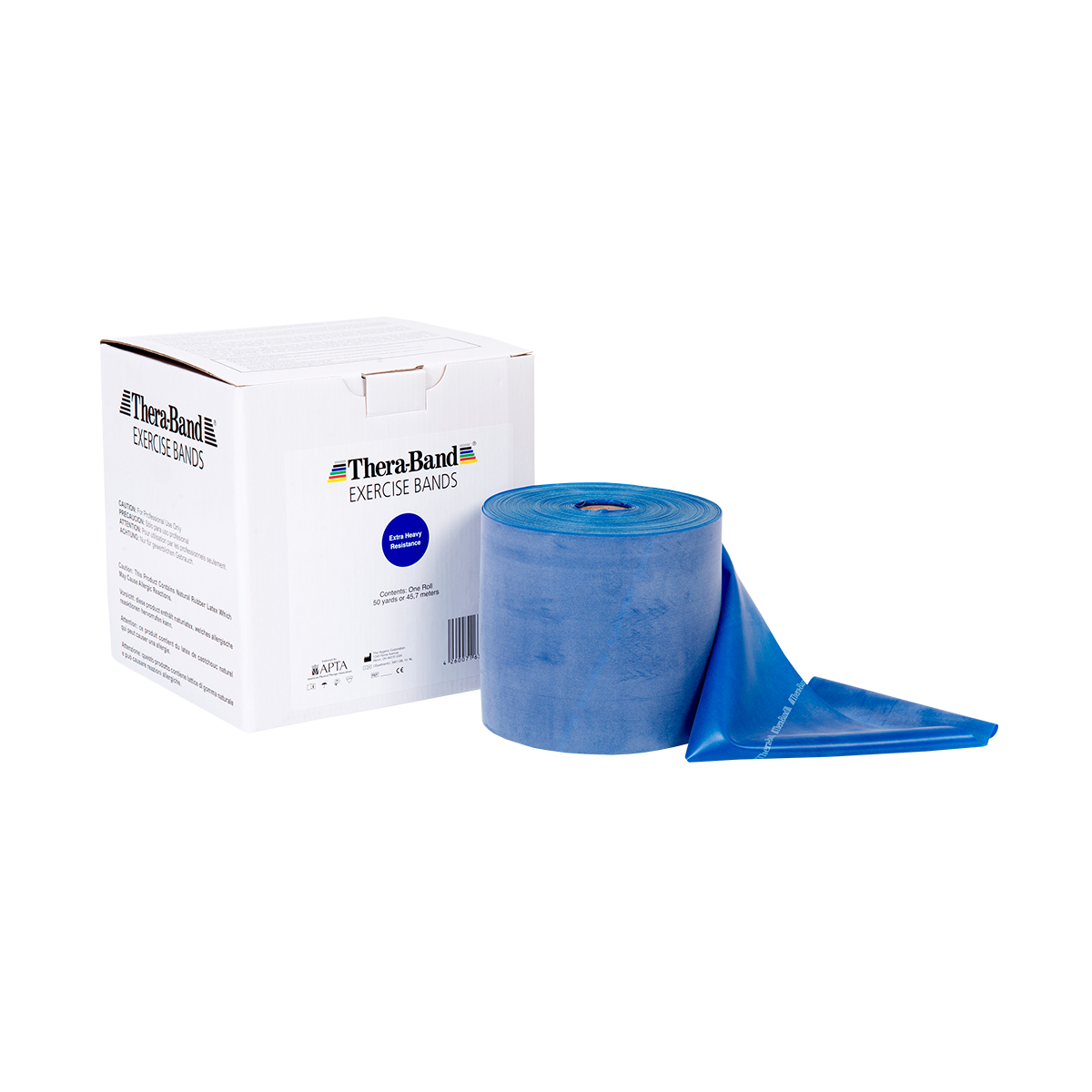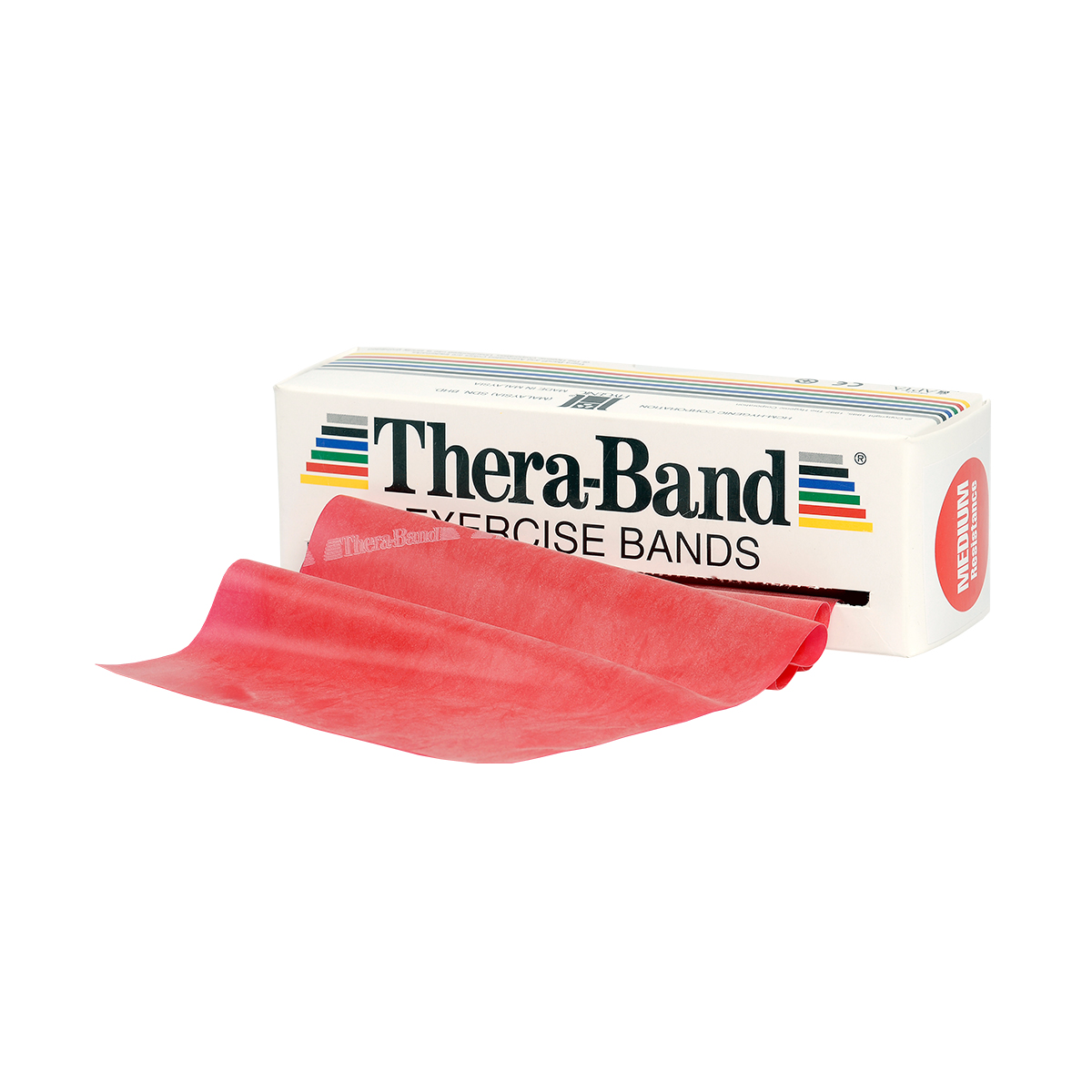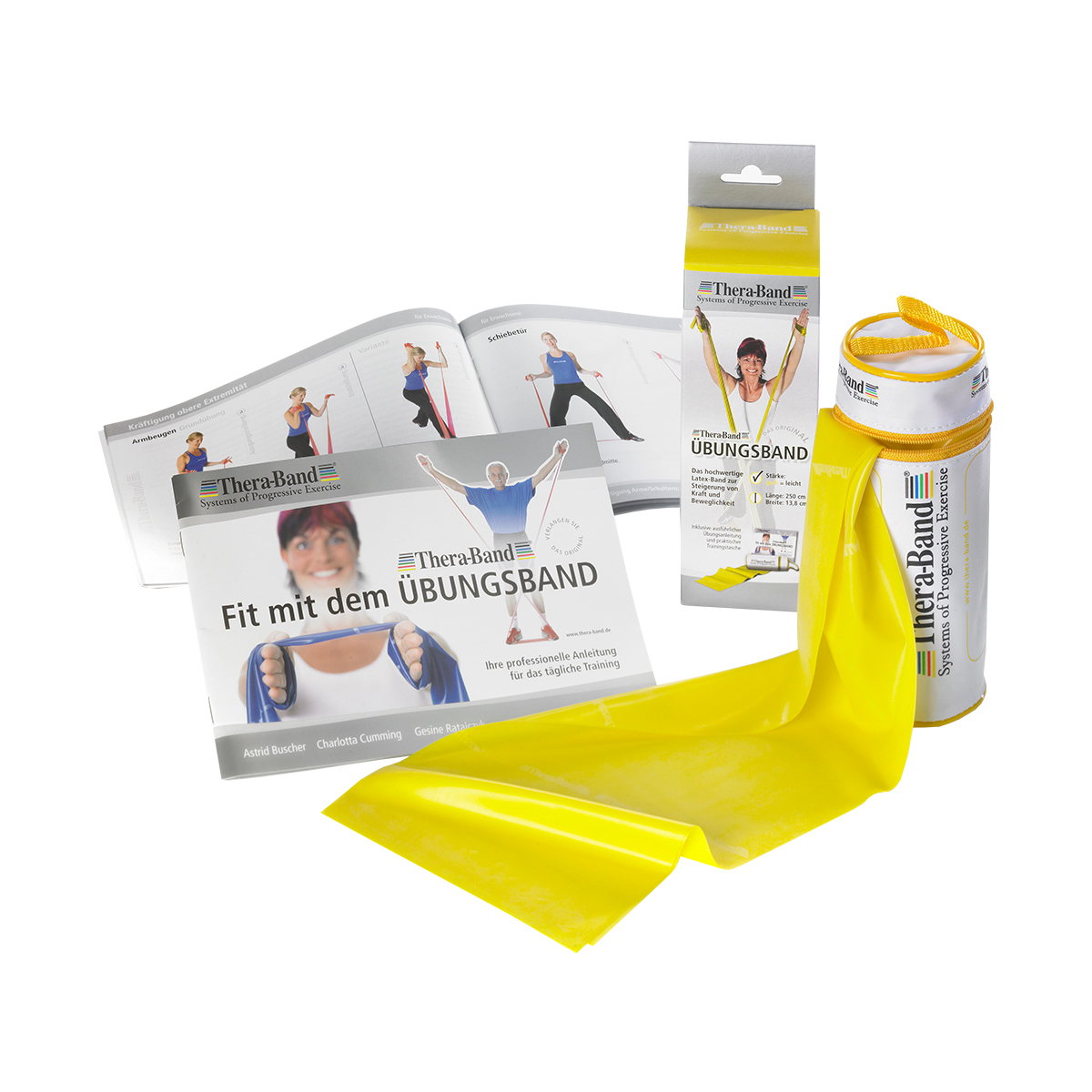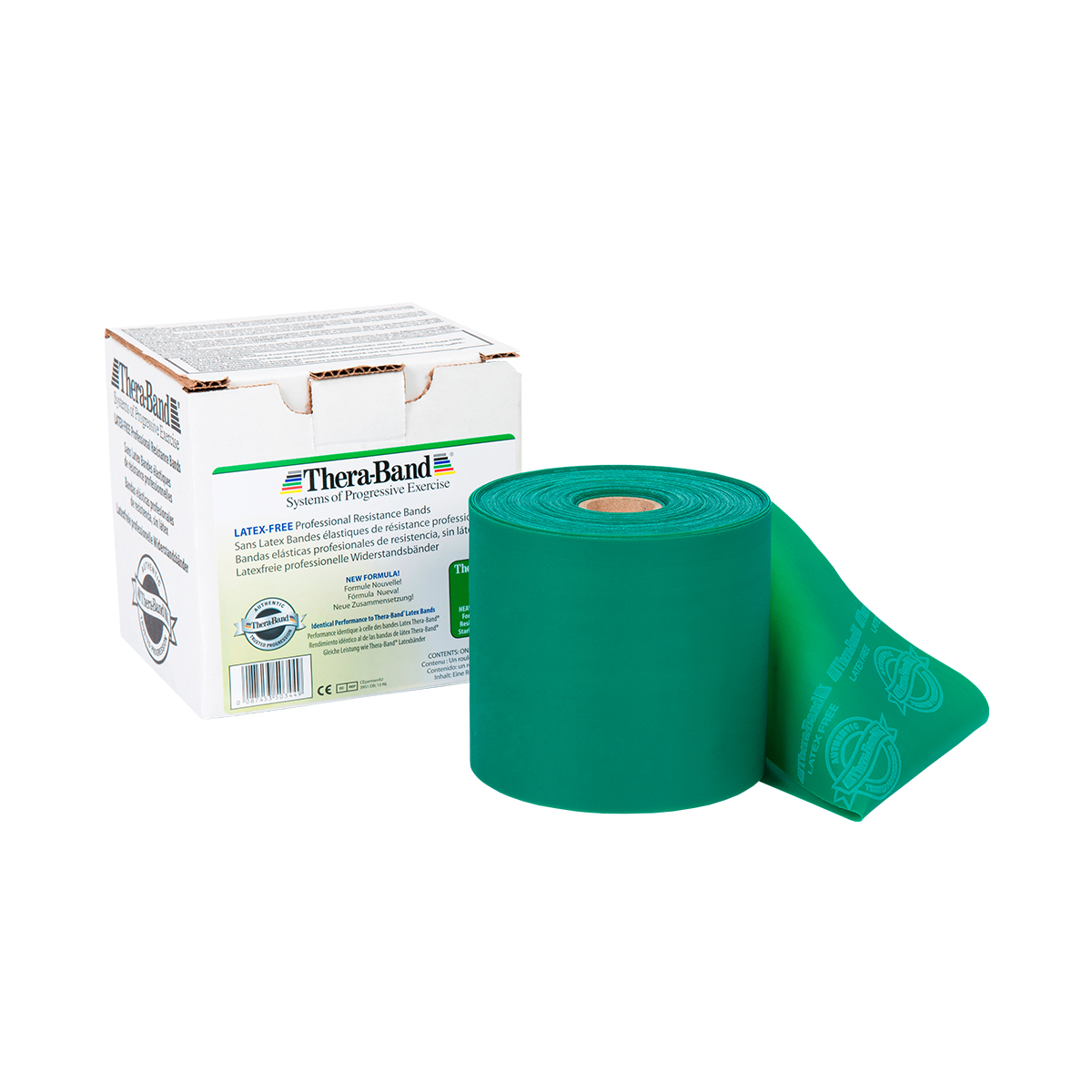
The best-known resistance bands in the world - Theraband®
The classic Theraband was initially used mainly in physiotherapy and rehabilitation. Today, millions train with the elastic resistance band. A Theraband is made of natural latex or a latex-free substitute. In addition to the original, the fitness band is available from various manufacturers, some of which use different materials. By the way, the white dust that lies on the band when it is packed is magnesium and keeps the exercise band supple.

The original for professional use. Handy and versatile, the Thera-Band exercise band is considered the smallest gym in the world. The linear force build-up with increasing stretching of the Thera-Band exercise bands is gentle on the the joints and prevents injuries - an essential plus in therapy and fitness training. 100% natural latex Linear strain behaviour: Force increases proportionally with elongation The classic for professional use Ideal for therapy, club and competitive sports For young and old and all fitness levels For isolated or cross-muscle training Almost unlimited application possibilities in strength and coordination training

The original for professional use. Handy and versatile, the Thera-Band exercise band is considered the smallest gym in the world. The linear force build-up with increasing stretching of the Thera-Band exercise bands is gentle on the the joints and prevents injuries - an essential plus in therapy and fitness training. 100% natural latex Linear strain behaviour: Force increases proportionally with elongation The classic for professional use Ideal for therapy, club and competitive sports For young and old and all fitness levels For isolated or cross-muscle training Almost unlimited application possibilities in strength and coordination training Including 32-page exercise instructions "Fit with the exercise tape Flexible use and safe stowage UV light protection thanks to storage bag The popular original exercise tape in the optimal length

The original for professional use. Handy and versatile, the Thera-Band exercise band is considered the smallest gym in the world. The linear force build-up with increasing stretching of the Thera-Band exercise bands is gentle on the the joints and prevents injuries - an essential plus in therapy and fitness training. 100% natural latex Linear strain behaviour: Force increases proportionally with elongation The classic for professional use Ideal for therapy, club and competitive sports For young and old and all fitness levels For isolated or cross-muscle training Almost unlimited possibilities for use in strength and coordination training Thanks to the practical zippered pocket it is safely stored and can be taken anywhere. Incl. practical zipper bag Including 32-page exercise instructions "Fit with the exercise tape As a 2.50 m long exercise band available in five resistance levels (yellow, red, green, blue and black) Flexible use and safe stowage UV light protection thanks to storage bag The popular original exercise tape in the optimal length

The latex-free Thera-Band exercise band is based on the unique resistance properties of the original latex exercise band from Thera-Band. It is therefore the only exercise band, which meets the market-leading system of progressive resistance. It is also powder and odorless. The colour coding is analogous to the classic exercise tape and thus offers familiar handling for all users. latex-free (suitable for allergy sufferers) powder free odourless available in 5 thicknesses by the inventors of the market-leading exercise tape with 30 years of experience Familiar colour coding - linear force-elongation behaviour 22 meters
For whom are Therabands suitable
The original use, which is intended to promote muscle development after injuries, is still current and useful. The gymnastic band offers a completely individual resistance training due to several strengths and absolute flexibility and always adapts optimally to the trainees. In addition to rehabilitation and physiotherapy, the Theraband has successfully found its way into sports such as yoga, fitness, Pilates, and even competitive sports. A huge advantage is that the band can be taken anywhere and allows extensive training of all muscle groups. At the same time, not only strength is trained, but also coordination. This means that the small muscles and the postural muscles are also allowed to work, which is good for the body.
Theraband in use:
- Strength training in rehabilitation, physiotherapy, and fitness
- Improving coordination
- Increasing mobility and flexibility
- Improving posture and balance
- Reduction of movement restrictions
- Functional training
What are the different colours of fitness bands all about?
The colour of a fitness band indicates how much resistance it has to stretching, i.e., the strength. Almost all manufacturers use the same colour code, but some manufacturers may have different colour classifications. For the classic Thera-Band, the strength is differentiated as follows (from light to heavy).
- Yellow offers a very light resistance (1.4 kg) and is therefore suitable for children and seniors as well as for rehabilitation and physio
- Red has a light resistance (1.7 kg) and is for untrained adults and teenagers as well as for rehab and physio
- Green is medium resistance (2.1 kg) and is the standard for adults. The band is suitable for regular strength sessions as well as rehab and physio
- Blueoffers strong resistance (2.6 kg) and is intended for trained adults
- Schwarz has a very strong resistance (3.3 kg) and is only for experts and trained athletes
- Silver and Gold are for athletes and professional athletes only. The resistance is extra strong with 4,6/ 6,4 kg.
Note: The resistance value in kilograms given in brackets refers to 100 percent stretch of the respective Thera-Band.
Choosing the right colour
We have already written behind the colours for whom which strength is intended. This can be taken as a guide. In addition, it depends a bit on the use and the regularity. Light fitness bands, for example, can also be used by athletes to warm up before going into full swing. Smaller muscle groups are also more likely to be trained with lighter exercise bands, larger muscles with stronger bands. Regular training also increases power, so you may want to switch to a different colour at some point. As you can see, there is no one right colour if you want to train with a Thera-Band more often. It's better to buy a small set of two or three colours.
How do I use a Theraband correctly - What do I need to watch out for?
Standing on it and just pulling it around is one way to start your workout, but probably not the best. If you already have experience with the basic principles, you can get lots of tips and new exercises from videos and guides on the web and increase your strength, flexibility, and coordination step by step. The best thing is to have an experienced trainer who can explain each exercise to you and correct your mistakes at the same time.
The most important thing is to maintain a correct posture that is easy on the joints. This means, among other things, keeping the back straight and stable and making the movements in natural directions. For many exercises, the Theraband is fixed to an object or bar. These should of course be stable so that nothing tips over at the end.
The stretching itself should be fluid and even. If you must jerk to stretch, then you are training with too much resistance and should choose a lighter band/colour. If the resistance is too light, you can double the band and increase the strength twofold.
Which muscles can I train with a Theraband?
The beauty of fitness bands is that you can use them to work all the muscles in your body. You can work small and large muscles and, above all, whole muscle chains for a functional workout. The internet is full of instructions and exercise ideas, so dare to try something new. If you are busy with rehab and physio, you can get your exercises directly from the therapist and trainer.
A few more important ground rules for training with the Theraband:
1. Pointed objects such as zips, sharp fingernails or hand jewellery can damage the rubber. Therefore, do not hold the band in a fist, as your fingernails will press directly on the exercise band.
2. For movements with greater amplitude, where the exercise band runs over a fixed point such as a pull-up bar, always grab the ends of the Theraband and stand as far away from the fixed point as is necessary to achieve sufficient strength, as necessary to exert enough force.
3. Each exercise repetition should be controlled and even. If it becomes too hard, then rather hold static for a short time and take a break or change to a lighter colour.
4. Always maintain a slight basic tension during the exercise, even in the starting position, to protect the joints.
5. To prevent misalignment, the load should be evenly distributed between the left and right halves of the body.
6. In case of repeated pain that does not go away, the cause of the pain should be found with a doctor.
The right care for the Theraband
Fitness bands are super stretchy and can be used for any workout, but a little care is allowed. What they don't like is heat, direct sunlight, and dirt. You should also refrain from tying knots in them, as this puts unnecessary strain on the material. If you like, you can also use your Theraband in the swimming pool, but the chlorine contained in the water should be rinsed off with regular water after use. The band tolerates regular soap, but not chemical cleaning agents or disinfectants. These can damage the gymnastic band and make it porous and cracked. If the Theraband starts to stick after frequent use, talcum powder, magnesium powder or powder can be applied.
